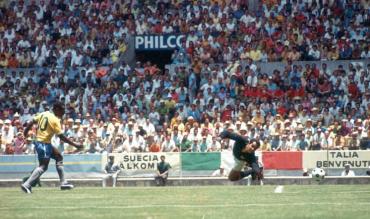It is fascinating to consider how much, or how little, the world knew of Edson Arantes do Nascimento, otherwise known as Pele, prior to the World Cup in 1958.
Certainly in Brazil, hype and excitement was starting to build around this precocious 17-year-old who made the practices of football appear so very easy and the impossible possible.
Elsewhere though, at a time when only the very well-off owned televisions, and it being half a century before Twitter was invented, to what extent was the rest of the planet aware that a phenomenon was about to strike? A genuine game-changer.
Perhaps, there was an article in the Times. Perhaps.

Or what’s the betting not, because Pele wasn’t actually expected to be selected by Selecao, struggling as he was with a knee injury.
This explains his absence from Brazil’s first two games in Sweden, the second of which was against an England side that contained Tom Finney and a future Three Lions boss in Bobby Robson.
For Brazil’s third group game, against Russia, manager Vicente Feola made sweeping changes, bringing in three debutants and if this was Pele’s introduction to the world it also partly answers the poser above.
Because on hearing their opponents were fielding three ‘reserves’ Russia’s manager rushed to tell his team the good news, that Brazil were ‘weakened’.
Two of those three were Pele and the irrepressible, unbelievable Garrincha.
It took just three minutes for Russia to rue their complacency and ignorance, as both Pele and Garrincha hit the woodwork in an opening blitzkrieg of samba brilliance.
By the game’s end, esteemed journalist Brian Granville had seen enough to commit in print that Pele was a ‘genus’, an estimation shared soon-after by millions.
Then came a quarter-final clash with Wales on June 19th, 1958, the Dragons if not over-achieving then certainly surprising themselves in reaching this late juncture of the competition.
A full hour into the contest, one that saw the underdogs applying themselves well, it happened, the great man’s first ever World Cup goal.
The ball arrived on Pele’s chest deep into the penalty area, with his back to goal.
Wales’ legendary centre-half Mel Charles made the grave error of taking a micro-step back, to better assess the situation, and that was all the space and opportunity Pele needed to flick the ball and spin, volleying home from close range.
As he followed the ball into the net and collapsed into the netting a phalanx of photographers rushed to join him, capturing this historic moment, one that maybe nobody knew at the time was going to be so historic.
58 years ago today, A 17-year old @Pele scores his first World Cup goal against Wales in the 1958 WC quarter-finals. pic.twitter.com/vWyBtNDUeA
— The Antique Football (@AntiqueFootball) June 19, 2016
They had a much better understanding of its significance five days later, when a 17-year-old kid, blessed with the talent of a hundred grown-ups, fired a sensational hat-trick in a semi-final rout of France.
Just imagine for a moment what the live betting markets would have looked like, had they been around in that era. 50/1 on this little-known boy wonder scoring. 25/1. 10/1. Evens.
It was the announcement of pure genius played out in real time, occurring before the eyes of those fortunate to see it.
A week later, Pele scored another two in the World Cup final. Of course he did. He made the impossible possible, right from the off.
*Credit for all of the photos in this article belongs to AP Photo*


